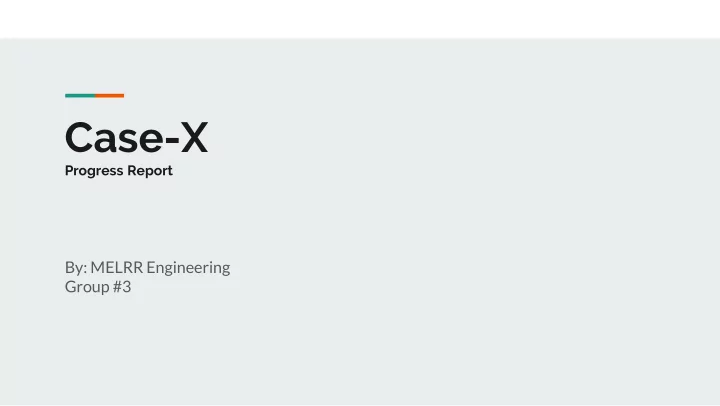

Case-X Progress Report By: MELRR Engineering Group #3
Weekly Updates Week Week Week Week #1 #2 #3 #4 Dimensions and Finalize Design Materials Mechanics Weight - Determined volume and - Finished design of - Determined materials for case, - Completed calculations weight of solution and desired compartments nozzle and compartment. for internal mechanics dimensions for compartments - Completed drawings - Began cost evaluation for all and case materials
Case Dimensions Length 15cm ● Width 6cm ● Height 5.8 cm ( 1.8cm larger than the height of an average glasses case to provide room for the ● fluid compartment and mechanics)
Volume Calculations Volume formula for a rectangular prism (L x W x H) ● Outer Volume: 15cm x 6cm x 5.8cm = 522cm^3 ● Inner Volume: (15-0.10)cm x (6-0.10)cm x (5.8-0.10)cm = 501.087cm^3 ● Total volume of material needed: (522-501.087) = 20.913cm^3 ●
Weight Calculations Weight of solution (max filled) ● 75% rubbing alcohol ○ (0.75)(94.5mL)(1cm^3/1mL)(0.78509 g/cm^3) = 55.643 g ■ 25% water ○ ■ (0.25)(94.5mL)(1cm^3/1mL)(1g/cm^3) = 23.625 g 2 drops soap ○ (0.1mL)(1cm^3/1mL)(0.801g/cm^3) = 0.0801 g ■ Total weight of solution = 79.3481 g ●
Fluid Compartment The compartment that will hold the cleaning solution will be a 8.80 x 6 x 1.8 cm plastic casing capable of holding 95 ● mL. Plastic will keep the cleaning solution from leaking into the glasses compartment of the case. ● ● We expect that the 95mL of solution will last the user over a month and a half. Calculations We estimated that a person would on average clean their glasses 5 times per day, at an average of 6 sprays per clean, where the average spray nozzle of our caliber dispenses 1mL per 12-15 sprays. 5 cleans per day x 6 sprays per clean = 30 sprays per day ● 1 mL x 2 = 2 mL per day ● ● 94.5 mL/ 2 mL per day = 47.25 days
Final Design Designed to carry 95mL of liquid (maximum) ● ○ Able to take with you on airplane Contains: ● Two metal hinges to allow the case to open and close properly ○ Compartment to hold cleaning solution ○ Compartment to hold mircofibre cloth ○ Push-pin nozzle ○ Various other mechanical components ○
Design Drawings
Materials for the Casing We are looking into 3D printing our design, in order to produce a working prototype ● Materials needed to construct the exterior of the case: ● Carbon fibre as the exterior material to minimize the mass and keep the case strong and sleek. ● A protective layer of foam material to sit between the exterior and interior of the case to absorb ● the force if the case is dropped. Thick microfiber velvet material to line the inside of the case. This material is similar to that used in ● other cases and will act to protect the lenses from scratches.
Carbon Fiber Option Density of carbon fiber: 2.00g/cm^3 ● Total weight of material needed: 2.00g/cm^3 x 20.913cm^3 = 41.826g ● Cost of carbon fiber is about $182/kg Canadian ● ($182)(0.041826kg) = $7.61 ●
Cost of Materials Carbon Fiber - $182/Kg ● $ 7.61 per unit ○ Spray nozzle - $25/50 nozzle ● $0.50 per unit ○ Microfibre Velvet lining - $3.80/m ● $0.08 per unit ○ Metal Hinges - $0.20/hinge ● $0.40 per unit ○ Foam - $34/bundle (1 bundle = 0.15m x 380m) ● $0.04 per unit ○ TOTAL COST PER UNIT: $8.63 ●
Total Weight Weight of solution (max filled) + weight of case ● 41.826g + 79.3481g = 121.1741g ○
Projected Timeline March 10th - 17th March 17th - 24th March 24th - 31st March 3rd - 10th Establish how we Build the prototype Evaluations Final Report will build prototype - Meet with Paul - Perform total cost - Finish final report - Complete 3D printing of evaluation - Prepare for final each part - Prepare for 3D printing - Complete performance presentation evaluation of the case - Assemble the pieces - Gather necessary materials
Recommend
More recommend